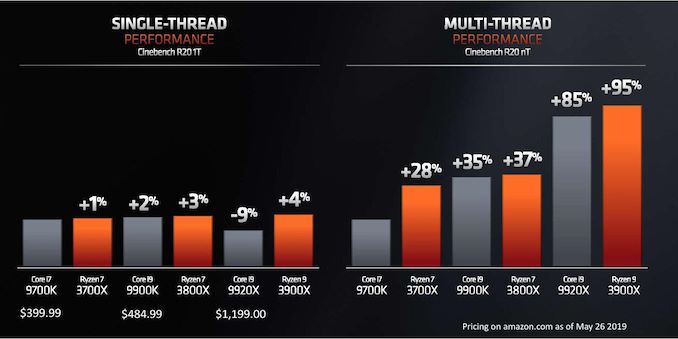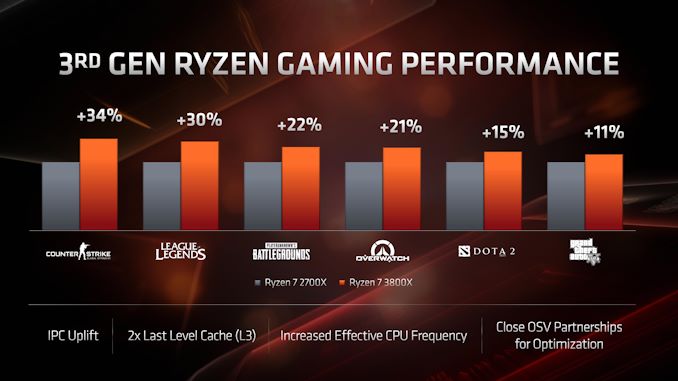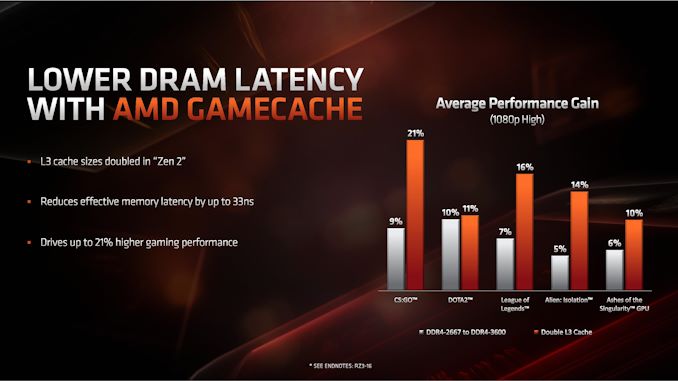AMD Zen 2 Microarchitecture Analysis: Ryzen 3000 and EPYC Rome
by Dr. Ian Cutress on June 10, 2019 7:22 PM EST- Posted in
- CPUs
- AMD
- Ryzen
- EPYC
- Infinity Fabric
- PCIe 4.0
- Zen 2
- Rome
- Ryzen 3000
- Ryzen 3rd Gen
Performance Claims of Zen 2
At Computex, AMD announced that it had designed Zen 2 to offer a direct +15% raw performance gain over its Zen+ platform when comparing two processors at the same frequency. At the same time, AMD also claims that at the same power, Zen 2 will offer greater than a >1.25x performance gain at the same power, or up to half power at the same performance. Combining this together, for select benchmarks, AMD is claiming a +75% performance per watt gain over its previous generation product, and a +45% performance per watt gain over its competition.
These are numbers we can’t verify at this point, as we do not have the products in hand, and when we do the embargo for benchmarking results will lift on July 7th. AMD did spend a good amount of time going through the new changes in the microarchitecture for Zen 2, as well as platform level changes, in order to show how the product has improved over the previous generation.
It should also be noted that at multiple times during AMD’s recent Tech Day, the company stated that they are not interested in going back-and-forth with its primary competition on incremental updates to try and beat one another, which might result in holding technology back. AMD is committed, according to its executives, to pushing the envelope of performance as much as it can every generation, regardless of the competition. Both CEO Dr. Lisa Su, and CTO Mark Papermaster, have said that they expected the timeline of the launch of their Zen 2 portfolio to intersect with a very competitive Intel 10nm product line. Despite this not being the case, the AMD executives stated they are still pushing ahead with their roadmap as planned.
| AMD 'Matisse' Ryzen 3000 Series CPUs | |||||||||||
| AnandTech | Cores Threads |
Base Freq |
Boost Freq |
L2 Cache |
L3 Cache |
PCIe 4.0 |
DDR4 | TDP | Price (SEP) |
||
| Ryzen 9 | 3950X | 16C | 32T | 3.5 | 4.7 | 8 MB | 64 MB | 16+4+4 | 3200 | 105W | $749 |
| Ryzen 9 | 3900X | 12C | 24T | 3.8 | 4.6 | 6 MB | 64 MB | 16+4+4 | 3200 | 105W | $499 |
| Ryzen 7 | 3800X | 8C | 16T | 3.9 | 4.5 | 4 MB | 32 MB | 16+4+4 | 3200 | 105W | $399 |
| Ryzen 7 | 3700X | 8C | 16T | 3.6 | 4.4 | 4 MB | 32 MB | 16+4+4 | 3200 | 65W | $329 |
| Ryzen 5 | 3600X | 6C | 12T | 3.8 | 4.4 | 3 MB | 32 MB | 16+4+4 | 3200 | 95W | $249 |
| Ryzen 5 | 3600 | 6C | 12T | 3.6 | 4.2 | 3 MB | 32 MB | 16+4+4 | 3200 | 65W | $199 |
AMD’s benchmark of choice, when showcasing the performance of its upcoming Matisse processors is Cinebench. Cinebench a floating point benchmark which the company has historically done very well on, and tends to probe the CPU FP performance as well as cache performance, although it ends up often not involving much of the memory subsystem.
Back at CES 2019 in January, AMD showed an un-named 8-core Zen 2 processor against Intel’s high-end 8-core processor, the i9-9900K, on Cinebench R15, where the systems scored about the same result, but with the AMD full system consuming around 1/3 or more less power. For Computex in May, AMD disclosed a lot of the eight and twelve-core details, along with how these chips compare in single and multi-threaded Cinebench R20 results.
AMD is stating that its new processors, when comparing across core counts, offer better single thread performance, better multi-thread performance, at a lower power and a much lower price point when it comes to CPU benchmarks.
When it comes to gaming, AMD is rather bullish on this front. At 1080p, comparing the Ryzen 7 2700X to the Ryzen 7 3800X, AMD is expecting anywhere from a +11% to a +34% increase in frame rates generation to generation.
When it comes to comparing gaming between AMD and Intel processors, AMD stuck to 1080p testing of popular titles, again comparing similar processors for core counts and pricing. In pretty much every comparison, it was a back and forth between the AMD product and the Intel product – AMD would win some, loses some, or draws in others. Here’s the $250 comparison as an example:
Performance in gaming in this case was designed to showcase the frequency and IPC improvements, rather than any benefits from PCIe 4.0. On the frequency side, AMD stated that despite the 7nm die shrink and higher resistivity of the pathways, they were able to extract a higher frequency out of the 7nm TSMC process compared to 14nm and 12nm from Global Foundries.
AMD also made commentary about the new L3 cache design, as it moves from 2 MB/core to 4 MB/core. Doubling the L3 cache, according to AMD, affords an additional +11% to +21% increase in performance at 1080p for gaming with a discrete GPU.
There are some new instructions on Zen 2 that would be able to assist in verifying these numbers.















216 Comments
View All Comments
Korguz - Monday, June 17, 2019 - link
im glad im not the only one that sees this...Qasar - Monday, June 17, 2019 - link
korguz, you aren't the only one that sees it.Xyler94, i dont hate intel.. but i am sick of what they have done so far to the cpu industry, sticking the mainstream with quad cores for how many years ? i would of loved to get a 6 or 8 core intel chip, but the cost of the platform, made it out of my reach. the little performance gains year over year, come on, thats the best intel can do with all the money they have ?? and the constant lies about 10nm.... then Zen is released and what was it, less then 2 months later, intel all of a sudden has more then 4 cores for the mainstream, and even more cores for the HEDT ? my next upgrade at this point, looks to be zen 2.. but i am waiting till the 7th, to read the reviews. hstewart does glorify intel any chance he can, and it just looks so stupid, cause some one calls him out on it.. and he seems to pretty much vanish from that convo
HStewart - Thursday, June 13, 2019 - link
Notice that I mention unless they change it from dual 128 bit.Targon - Thursday, June 13, 2019 - link
Socket AM4 is limited to a dual-channel memory controller, because you need more pins to add more memory channels. The same applies to the number of PCI Express lanes as well. The only way around this would be to use one of the abilities of Gen-Z where the CPU would just talk to the Gen-Z bus, at which point, dedicated pins for memory and PCI Express could be replaced by a very wide and fast connection to the system bus/fabric. Since that would require a new motherboard and for the CPU to be designed around it, why bother with socket AM4 at that point?Korguz - Thursday, June 13, 2019 - link
why bother?? um upgrade ability ? maybe not quite needed ? the things you suggest, sound like they would be a little expensive to implement. if you need more memory bandwidth and pcie lanes.. grab a TR board and a lower end cpu....austinsguitar - Monday, June 10, 2019 - link
Thank you Ian for this write up. :)megapleb - Monday, June 10, 2019 - link
Why does the 3600X have power consumption of 95W, and the 3700X, with two more cores, four more threads, and the same frequency max, consume only 65W? I'm guessing those two got switched around?anonomouse - Monday, June 10, 2019 - link
higher sustained base clock drives up the tdpmegapleb - Monday, June 10, 2019 - link
200Mhz extra base increases power consumption by 46%? I would have though max power consumption would be all cores operating at maximum frequency so the base would have nothing to do with it?scineram - Tuesday, June 11, 2019 - link
Nobody said anything about power consumption.